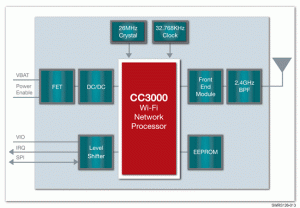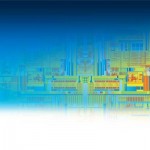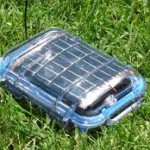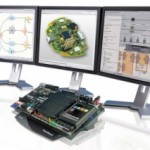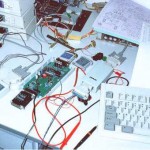The fact that the Internet of Things shows a lot of promise both now and in the future is certain – and your customers, designers and the public will have an almost limitless amount of ideas with regards to new products and their implementation. However when the time comes to select the hardware to drive these innovations, choosing from one of the wireless chipsets can be a minefield – and more so when WiFi is involved.
802.11 wireless LAN is an attractive technology for building networks of wireless sensors and embedded devices due to its widespread use and the availability of nearly ubiquitous existing network infrastructure. Let’s take a look at a few existing chipsets on the market today that can be used to add wireless networking to existing embedded designs with relatively low complexity and cost.
First there’s the RN131 802.11b/g WiFi module by Roving Networks – a complete low-power embedded networking solution. It incorporates a 2.4 GHz radio, processor, TCP/IP stack, real-time clock, crypto accelerator, power management and analogue sensor interfaces into a single, relatively power-efficient module. In the most simple configuration, the hardware requires only 3.3V power, ground, and a pair of serial UART lines for connection to an existing microcontroller, allowing wireless networking to easily be added to an existing embedded system.
The module incorporates a U.FL connector for connection of an external antenna, without any microwave layout or design needed to use the module. This module has a current consumption of 40mA when awake and receiving, 200mA when actively transmitting, and 4µA when asleep, and the device can wake up, connect to a WiFi network, send data, and return to sleep mode in less than 100 milliseconds. This makes it possible to achieve a runtime on the order of years from a pair of standard AA batteries – an ideal solution for power-efficient, battery powered wireless sensor network and Internet-of-Things solutions.
Next there’s the Texas Instruments CC3000 Wireless Network Processor – which allows WiFi to be added to any existing microcontroller system relatively easily, and at a low cost. The CC3000 integrates an entire IPv4 TCP/IP stack, WiFi driver and security supplicant on the chip, making it easily portable to lightweight microcontrollers without the memory burden of implementing a TCP/IP stack in the host microcontroller where relatively low-power, low-cost microcontrollers such as 8-bit AVR or PIC devices are used. And this compact module measures only 16.3mm x 13.5mm.
CC3000 reference designs available from TI demonstrate chip-antenna based designs that are already FCC, IC and CE certified, which can make it easier to develop bespoke solutions that can pass compliance testing for products going into markets where such compliance is needed. The CC3000 requires no external crystal or antenna balun, and in fact requires almost no external components at all except for an SPI interface to the host microcontroller and an antenna – and the device costs less than $10.
The flexible 2.7-4.8V power supply requirement offers great flexibility when combined with battery power or energy harvesting solutions. However, this chip is not a PCB-based module, meaning that a 50 ohm 2.4 GHz antenna must be added externally – so the designer must have a little familiarity with microwave design, such as microstrip transmission line layout and the choice of the right antenna connector. However, this offers the designer complete flexibility to choose the most appropriate antenna type for the size, range and gain requirements of the design – a larger external antenna, a compact chip antenna, or a microstrip antenna fabricated on the PCB with no bill-of-materials cost.
Our final subject is the Redpine Signals’ Connect-IO-n series of modules which allow 802.11 wireless LAN connectivity to be added relatively easily to an embedded microcontroller system. In collaboration with Atmel these modules have been optimised for use with Atmel microcontrollers, particularly the Atmel AVR XMEGA and AVR UC3 series microcontrollers.
Some modules in this family provide 802.11a/b/g/n Wi-Fi connectivity, whilst all modules provide the TCP/IP stack on board and are FCC certified, making RF compliance certification of your entire design easier. These modules are aimed at providing the ability to add 802.11 wireless connectivity to 8-bit and 16-bit microcontrollers with low integration effort and low memory footprint required in the host microcontroller to support the WiFi device, especially where 802.11n support is desired.
Like the other chipsets we’ve discussed, the modules in this series can be interfaced to the host microcontroller over a UART or SPI interface, and similarly to their competitors, a standby current consumption of only a few microamps potentially allows for years of battery life with no external energy source as long as the radio is only briefly enabled when it is needed.
The RedPine RS9110-N-11-28 module from the Connect-IO-n family in particular is relatively unusual in that it provides dual-band 2.4GHz/5GHz 802.11 a/b/g/n connectivity for your embedded device – supporting connection to any WiFi device or network and potentially avoiding congestion in the 2.4 GHz band as used with 802.11b/g devices.
Whilst 802.11n offers a significant increase in the maximum net data rate from the 54 MBit/s of 802.11b/g to 600 Mbit/s, do you really need 600 Mbit/s of data to your wireless sensor network or embedded appliance? I doubt it. However, one case where you might want an 802.11n radio supporting operation in the 5 GHz spectrum for your wireless sensor network device is if your wireless LAN infrastructure is a pure 5 GHz 802.11n network – whilst this breaks compatibility with legacy devices, it delivers maximum network performance.
As you can see the possibilities for low-power connected devices are plentiful and the hardware is available on the open market. It’s then up to your team to turn great ideas into great products. Furthermore modifying existing products to become connected is also a possibility. However if wireless or Internet-connectivity is new to your team – and you’re in a hurry, have a reduced R&D budget, need guidance or want to outsource the entire project – it can be done with the right technology partner.
Here at the LX Group we have the experience and team to make things happen. With our experience with connected devices, embedded and wireless hardware/software design, and ability to transfer ideas from the whiteboard to the white box – we can partner with you for your success.
We can create or tailor just about anything from a wireless temperature sensor to a complete Internet-enabled system for you – within your required time-frame and your budget. For more information or a confidential discussion about your ideas and how we can help bring them to life – click here to contact us, or telephone 1800 810 124.
LX is an award-winning electronics design company based in Sydney, Australia. LX services include full turnkey design, electronics, hardware, software and firmware design. LX specialises in embedded systems and wireless technologies design. https://lx-group.com.au
Published by LX Pty Ltd for itself and the LX Group of companies, including LX Design House, LX Solutions and LX Consulting, LX Innovations.

